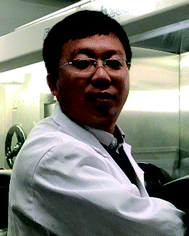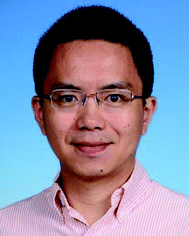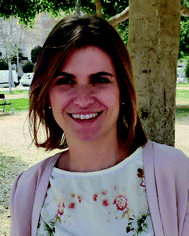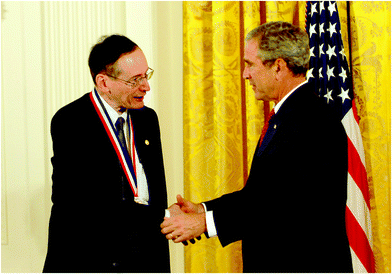Tobin Marks’ 75th birthday. A celebration of a career devoted to materials chemistry
Antonio
Facchetti
 *a,
Hui
Huang
*a,
Hui
Huang
 b,
He
Yan
b,
He
Yan
 c and
Rocio
Ponce Ortiz
c and
Rocio
Ponce Ortiz
 d
d
aDepartment of Chemistry and Materials Research Center, Northwestern University, Evanston, Illinois, USA. E-mail: a-facchetti@northwestern.edu
bUniversity of Chinese Academy of Sciences, Beijing, P. R. China. E-mail: huihuang@ucas.ac.cn
cDepartment of Chemistry, The Hong Kong University of Science and Technology, Clear Water Bay, Kowloon, Hong Kong. E-mail: hyan@ust.hk
dDepartment of Physical Chemistry, University of Málaga, Málaga, Spain. E-mail: rocioponce@uma.es
In this issue of Journal of Materials Chemistry C we celebrate Professor Tobin J. Marks’ 75th birthday and pay tribute to a career spanning over five decades, devoted in large part to pioneering research in unconventional opto-electronic materials. The quantity and quality of Tobin's contribution in this field, accounting for >1000 publications and >100 US patents, has impacted society and will continue to define this research and technology area for the years to come. His talents in materials design, synthetic strategies, materials processing and integration, device engineering, and prototyping have enabled ground-breaking discoveries in diverse opto-electronic materials classes and devices, in the areas of organic electro-optics,1 organic transistors,2 organic light-emitting diodes,3 organic solar cells,4 metal oxide conductors,5 and printed electronics,6 to cite just a few of them. His work has been recognized by many awards (Fig. 1), among them the US National Medal of Science; the ACS Priestley Medal; the MRS Von Hippel Award; the Dreyfus Prize in the Chemical Sciences; the National Academy of Sciences Award in Chemical Sciences; ACS Awards in Polymeric Materials and Materials Chemistry; the ACS William Gibbs Medal; the ACS Linus Pauling Award; and the American Institute of Chemists Gold Medal. He is also a Fellow of the American Academy of Arts and Sciences; a Member of the US National Academy of Sciences; a Fellow of the Materials Research Society and the Royal Society of Chemistry; a Member of the US National Academy of Engineering; and a Fellow of the US National Academy of Inventors.
Several articles included in this themed issue have been undoubtedly influenced by Tobin's seminal papers in unconventional opto-electronics. For instance, one of the most important contributions of Tobin's research in organic electronics has been the understanding-based design of several electron-transporting (n-type) semiconductors.7 Here, some studies, such as those by Usta et al. (DOI: 10.1039/D0TC02945A), Würthner et al. (DOI: 10.1039/D0TC02988B) and Segura et al. (DOI: 10.1039/D0TC03026K), where the materials’ performance critically depends on the semiconductor's lowest unoccupied molecular orbital (LUMO) energy, have benefited from Tobin's earlier contributions on the selective tuning of frontier molecular orbital energetics by rational substitution of oligothiophene and arylene diimide conjugated skeletons with electron-withdrawing functionalities.8,9
Some other contributions to this themed issue deal with solution processable polymeric materials, which are essential for achieving cost-effective and flexible electronic devices. In this sense, the report by Caironi et al. (DOI: 10.1039/D0TC03064C) reports the first demonstration of semi-transparent and fully organic crumpable printed circuits, which are aimed to be integrated into consumer products. Also, printed, cost-effective and stable electrolyte-gated field-effect transistors to be used in organic bioelectronic sensors are reported here by Torsi et al. (DOI: 10.1039/D0TC03342A). Tobin's wide experience and contributions to the development of novel polymeric materials, and especially of n-type and ambipolar polymeric materials10,11 and recent contribution to electrochemical transistors,12 have provided a plethora of efficient materials and synthetic strategies to enable the realization of high-performance and flexible electronic devices. The report of Medvedeva et al. (DOI: 10.1039/D0TC03370G) on doping amorphous metal oxide semiconductors also relates to Tobin's pioneering works on solution processing amorphous oxide semiconductors for transparent, flexible, and printed electronics,13 and to his efforts to lower their processing temperature for compatibility with inexpensive plastic substrates.14
Tobin is one of the major players in developing various types of thin-film solar cells including those based on organic donor and acceptor semiconductors for charge generation and interfacial charge transport. One of Tobin's contributions addressed how side chain substituent engineering of the donor and acceptor small-molecule/polymeric semiconductor affects solar cell efficiency,15 which led to the development of several high-performance materials and deeper understanding of the device working mechanism. Inspired by this progress, the manuscripts of Guo et al. (DOI: 10.1039/D0TC00087F) and Zhan et al. (DOI: 10.1039/D0TC02158J) in this issue focus on tuning the side chains to achieve high-performance acceptors.
Tobin also made milestone progress in the interfacial charge transport engineering of organic solar cells by using self-assembled molecular layers,16 inorganic metal oxides,17 as well as nanowires.18 Here, the papers by Kim et al. (DOI: 10.1039/D0TC02513E) and Huang et al. (DOI: 10.1039/D0TC03066J) report novel molecular/polymeric interfacial layers for tuning contact work functions, interlayer dipole moments and charge transport characteristics, resulting in highly efficient solar cells. Another important contribution from Tobin's laboratory, and his collaboration network, has concerned optimizing the photoactive layer morphology and understanding the mechanism of the semiconductor blend morphology evolution during processing.19 Undoubtedly, the manuscripts from Li et al. (DOI: 10.1039/D0TC03217D) and Chen et al. (DOI: 10.1039/D0TC03393F) about understanding the relationship between blend morphology and the photovoltaic cell performance parameters can be traced back to Tobin's important input in this field.
Interfacial chemistry and engineering of optoelectronic devices, driven by new materials, play a fundamental role in defining their stability to mechanical and operation stress and performance optimization. Examples of Tobin's contributions in this area are vast, with the most prominent developing silane-based crosslinkable/metal oxide interlayers that modify the interface of, or add an ultra-thin layer in between, a transparent conductor, a metal conductor, or dielectric film and the organic semiconducting layers.20–22 Presented in this issue are some latest developments of interfacial materials along the directions that Tobin has pioneered. One study here from Ng and co-workers (DOI: 10.1039/D0TC03013A) shows that using an interlayer with proper charge blocking properties reduces charge recombination probability and extends the lifetime of trapped holes, thereby enhancing the performance of photodetector devices. This paper directly relates to Tobin's earlier work of using hole-transporting/electron-blocking layers for OLEDs and organic solar cells. The highlight by Kim et al. (DOI: 10.1039/D0TC02379E) reports several examples where organic passivation layers can be important for stable metal oxide semiconductor devices, which parallel the pioneering studies of Tobin using organic silane molecules with metal oxide electrodes for modulators, light-emitting diodes, solar cells and transistors.
Finally, green chemistries prompted several discoveries in Tobin's group.23 A detailed review by Vaccaro et al. (DOI: 10.1039/D0TC03610B) summarizes key requirements for the solvents used in producing opto-electronic devices.
References
- Y. Shi, D. Frattarelli, N. Watanabe, A. Facchetti, E. Cariati, S. Righetto, E. Tordin, C. Zuccaccia, A. Macchioni, S. L. Wegener, C. L. Stern, M. A. Ratner and T. J. Marks, J. Am. Chem. Soc., 2015, 137, 12521–12538 CrossRef CAS.
- X. Guo, A. Facchetti and T. J. Marks, Chem. Rev., 2014, 114, 8943–9021 CrossRef CAS.
- S. Ju, J. Li, J. Liu, P.-C. Chen, Y.-g. Ha, F. Ishikawa, H. Chang, C. Zhou, A. Facchetti, D. B. Janes and T. J. Marks, Nano Lett., 2008, 8, 997–1004 CrossRef CAS.
- G. Wang, F. S. Melkonyan, A. Facchetti and T. J. Marks, Angew. Chem., Int. Ed., 2019, 58, 4129–4142 CrossRef CAS.
- X. Yu, T. J. Marks and A. Facchetti, Nat. Mater., 2016, 15, 383–396 CrossRef CAS.
- G. Wang, W. Huang, N. D. Eastham, S. Fabiano, E. F. Manley, L. Zeng, B. Wang, X. Zhang, Z. Chen, R. Li, R. P. H. Chang, L. X. Chen, M. J. Bedzyk, F. S. Melkonyan, A. Facchetti and T. J. Marks, Proc. Natl. Acad. Sci. U. S. A., 2017, 114, E10066 CrossRef CAS.
- H. Usta, A. Facchetti and T. J. Marks, Acc. Chem. Res., 2011, 44, 501–510 CrossRef CAS.
- A. Facchetti, M.-H. Yoon, C. L. Stern, H. E. Katz and T. J. Marks, Angew. Chem., Int. Ed., 2003, 42, 3900–3903 CrossRef CAS.
- J. A. Letizia, S. Cronin, R. P. Ortiz, A. Facchetti, M. A. Ratner and T. J. Marks, Chem. – Eur. J., 2010, 16, 1911–1928 CrossRef CAS.
- H. Huang, Z. Chen, R. P. Ortiz, C. Newman, H. Usta, S. Lou, J. Youn, Y.-Y. Noh, K.-J. Baeg, L. X. Chen, A. Facchetti and T. Marks, J. Am. Chem. Soc., 2012, 134, 10966–10973 CrossRef CAS.
- X. Guo, R. P. Ortiz, Y. Zheng, M.-G. Kim, S. Zhang, Y. Hu, G. Lu, A. Facchetti and T. J. Marks, J. Am. Chem. Soc., 2011, 133, 13685–13697 CrossRef CAS.
- X. Zhang, B. Wang, L. Huang, W. Huang, Z. Wang, W. Zhu, Y. Chen, A. Facchetti, T. J. Marks, X. Zhang, Y. Mao, L. Huang, Z. Wang and A. Facchetti, Sci. Adv., 2020, 6, eaaz1042 CrossRef CAS.
- J. Smith, L. Zeng, R. Khanal, K. Stallings, A. Facchetti, J. E. Medvedeva, M. J. Bedzyk and T. J. Marks, Adv. Electron. Mater., 2015, 1, 1500146 CrossRef.
- S. Jeong, Y.-G. Ha, J. Moon, A. Facchetti and T. J. Marks, Adv. Mater., 2010, 22, 1346–1350 CrossRef CAS.
- S. M. Swick, T. Gebraad, L. Jones, B. Fu, T. J. Aldrich, K. L. Kohlstedt, G. C. Schatz, A. Facchetti and T. J. Marks, ChemPhysChem, 2019, 20, 2608–2626 CrossRef CAS.
- L. Motiei, Y. Yao, J. Choudhury, H. Yan, T. J. Marks, M. E. vander Boom and A. Facchetti, J. Am. Chem. Soc., 2010, 132, 12528–12530 CrossRef CAS.
- M. D. Irwin, D. B. Buchholz, A. W. Hains, R. P. H. Chang and T. J. Marks, Proc. Natl. Acad. Sci. U. S. A., 2008, 105, 2783–2787 CrossRef CAS.
- C. K. Song, K. A. Luck, N. Zhou, L. Zeng, H. M. Heitzer, E. F. Manley, S. Goldman, L. X. Chen, M. A. Ratner, M. J. Bedzyk, R. P. H. Chang, M. C. Hersam and T. J. Marks, J. Am. Chem. Soc., 2014, 136, 17762–17773 CrossRef CAS.
- G. Wang, S. M. Swick, M. Matta, S. Mukherjee, J. W. Strzalka, J. L. Logsdon, S. Fabiano, W. Huang, T. J. Aldrich, T. Yang, A. Timalsina, N. Powers-Riggs, J. M. Alzola, R. M. Young, D. M. De Longchamp, M. R. Wasielewski, K. L. Kohlstedt, G. C. Schatz, F. S. Melkonyan, A. Facchetti and T. J. Marks, J. Am. Chem. Soc., 2019, 141, 13410–13420 CrossRef CAS.
- J. Cui, Q. Huang, J. G. C. Veinot, H. Yan and T. J. Marks, Adv. Mater., 2002, 14, 565–569 CrossRef CAS.
- N. Zhou, M.-G. Kim, S. Loser, J. Smith, H. Yoshida, X. Guo, C. Song, H. Jin, Z. Chen, S. M. Yoon, A. J. Freeman, R. P. H. Chang, A. Facchetti and T. J. Marks, Proc. Natl. Acad. Sci. U. S. A., 2015, 112, 7897–7902 CrossRef CAS.
- J. Youn, G. R. Dholakia, H. Huang, J. W. Hennek, A. Facchetti and T. J. Marks, Adv. Funct. Mater., 2012, 22, 1856–1869 CrossRef CAS.
- T. J. Aldrich, A. S. Dudnik, N. D. Eastham, E. F. Manley, L. X. Chen, R. P. H. Chang, F. S. Melkonyan, A. Facchetti and T. J. Marks, Macromolecules, 2018, 51, 9140–9155 CrossRef CAS.
| This journal is © The Royal Society of Chemistry 2020 |





